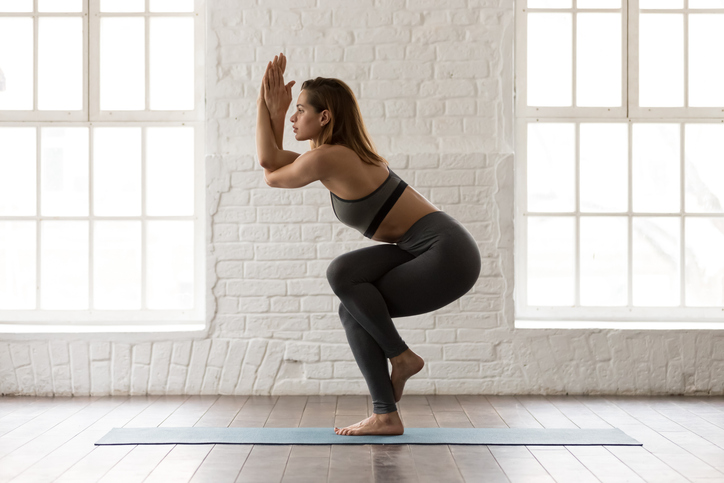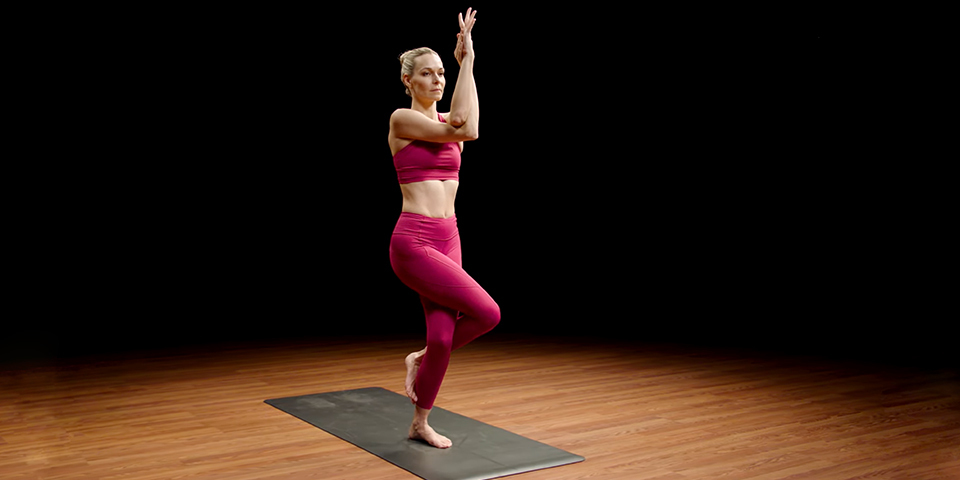Eagle pose (garudasana in Sanskrit) makes you feel like you’re being twisted like a pretzel but in the best possible way.
The classic version of garudasana requires focus and balance, which is among the first things to go as we age. Eagle pose is an excellent and playful way to access and strengthen your core muscles, work your legs and hips, and open your shoulders and upper back.
Brent Laffoon, an instructor in BODi’s Yoga52 series of practices, loves the story of the eponymous Garuda, a mythological Hindu figure who was half-man, half-bird. “As Garuda came of age, he diminished himself so he wouldn’t scare people,” Laffoon says.
“Then one day a gang of deceitful snakes took his mom hostage, and Garuda summoned all of his powers to save her. Thus, eagle pose reminds us not to make ourselves smaller, and to protect the feminine in order to not be taken advantage of.”
Eagle Pose (Garudasana): Step-by-Step Instructions
- Start in mountain pose (tadasana), standing tall with your feet together or hip-width apart and your hands at your sides.
- Bend your knees to lower your hips down and back, as if sinking into chair pose (utkatasana).
- Shift your weight onto your left foot and lift your right foot, crossing your right knee over your left knee. If possible, hook the top of your flexed right foot around the inside of your left ankle.
- Squeeze your legs together to maintain balance, and level your pelvis by drawing your left hip back and your right hip forward.
- Once your legs are established, cross your arms in front of you — right arm under the left — bend both elbows, and try to press your palms together.
- Lift your elbows to shoulder height, keeping them bent at 90 degrees.
- Hold the pose for five breaths, and reverse the sequence to return to mountain pose. Repeat with the opposite crossing of legs and arms.
How to Make Eagle Pose Easier
It’s easy to get frustrated while attempting garudasana. Fortunately, there are many ways to modify and/or prepare for eagle pose that can help demystify the posture.
1. Use a wall for balance
- Stand a foot away from a wall, facing it. Place your fingertips (not your whole hand) on the wall at shoulder height.
- Bend your knees as deeply as you can, keeping your weight in your heels. Practice picking up one leg and crossing it over the opposite leg, then switch. Use a free hand to help wrap your legs more tightly.
- When you feel steady enough, try taking your hands off the wall. Don’t drop your arms down by your side, rather try to keep them lifted so you can start practicing adding the arms component when you feel like your legs are fully supporting you.
2. Do ankle rotations
Even beyond their value at working up to garudasana, ankle exercises like this one are great to do regularly.
- Lie down on your back and lift your right leg.
- Bend your right knee and interlace your hands behind the back of your thigh.
- Keeping your leg stationary, perform a dozen or so very slow ankle circles clockwise, then counterclockwise.
- Slow is key. Decelerate when you find a sticky spot in your ankle mobility. Practice exploring where there is lack of movement rather than speeding past it.
- Switch legs and repeat.
3. Try reclined eagle pose
When you lie down on the floor for baddha garudasana, your nervous system quiets and balance is taken out of the equation. Using the feedback of the floor underneath your torso and lower body helps you to understand where you are in space and how to adjust your hips and shoulders to line up more evenly.
4. Be patient with your progress
Laffoon reminds us: “Wrapping the ankles requires a lot of mobility in the hips, and some people have such strong legs that the thighs and calves get in the way. There’s always value in just doing the best you can!”
How to Deepen Eagle Pose

As soon as you feel like you’ve “nailed” a pose, you may want to make it more challenging.
- Challenge your balance and try closing your eyes once you are in the pose. Maybe that means a long blink.
- Make garudasana even more interesting by playing on different surfaces. Try standing on a block or a bolster. If you don’t have yoga props, stand on your couch or your bed. Any unstable surface will further test your ability to support yourself and prepare you for life off the yoga mat.
- Another fun way to play in eagle pose, once you feel stable, is to gently move your elbows up and down. Again, disturbing your balance is the way to improve it.
How to Avoid Injury in Eagle Pose
Foremost when attempting to perform garudasana safely, do NOT force your knees to cross beyond their limits. Because you’re asking your legs to internally rotate while standing on one foot, you may find yourself cranking yourself into the pose quickly. Slow down and don’t force anything.
